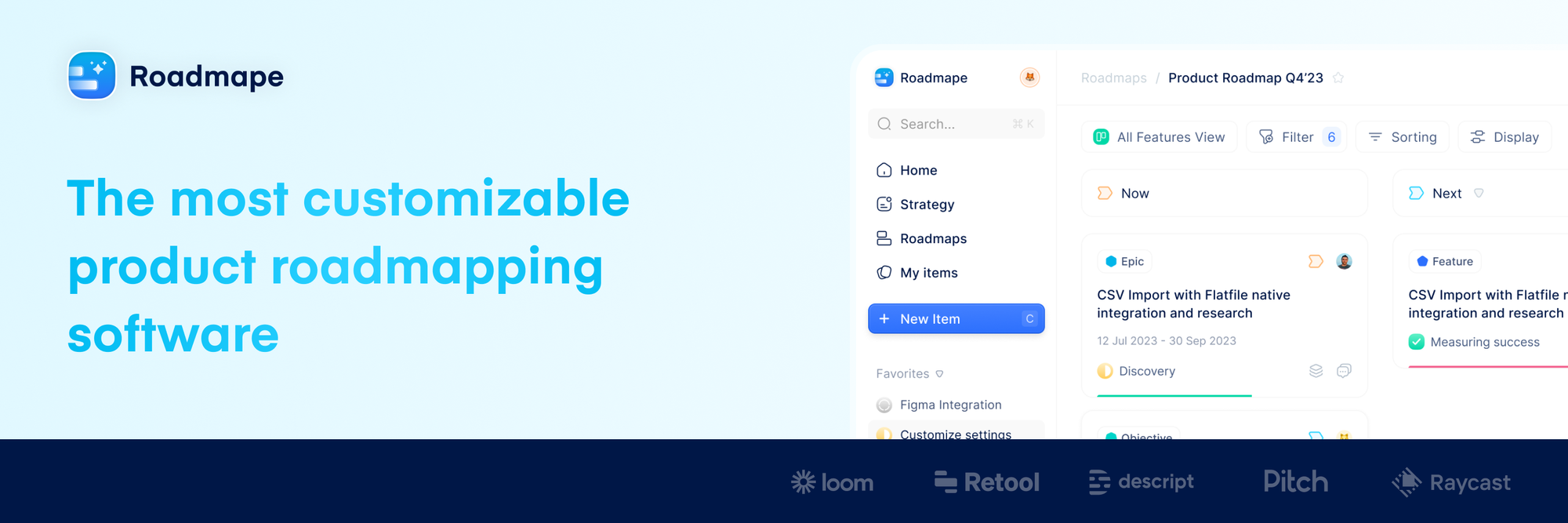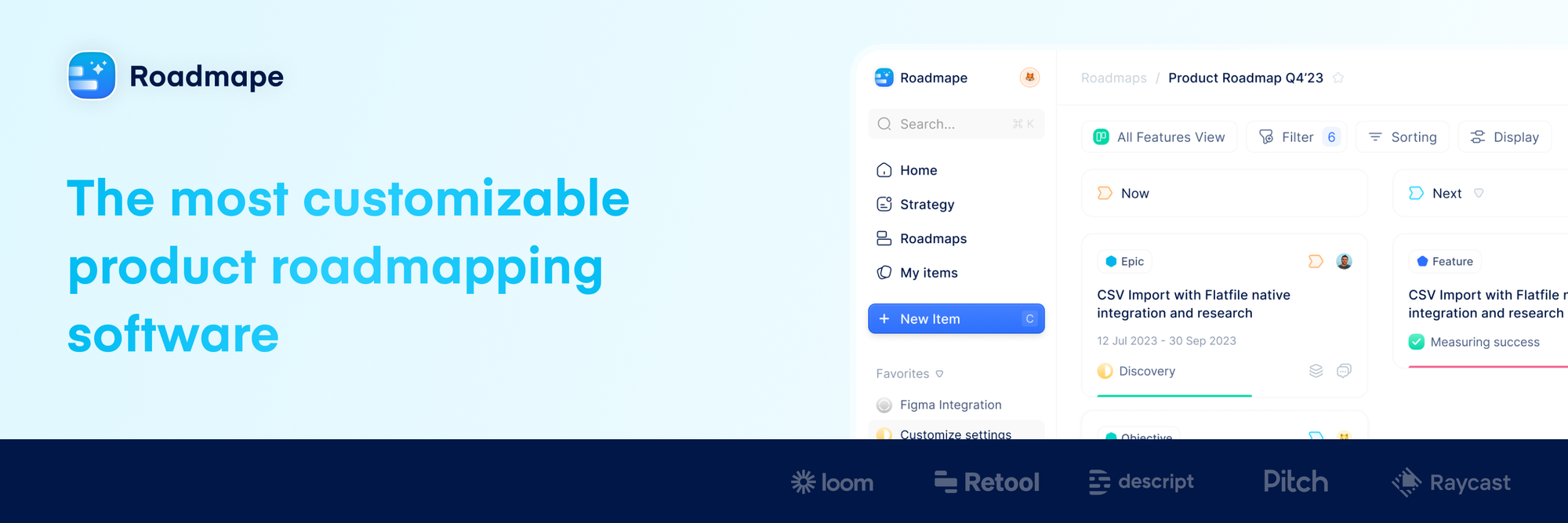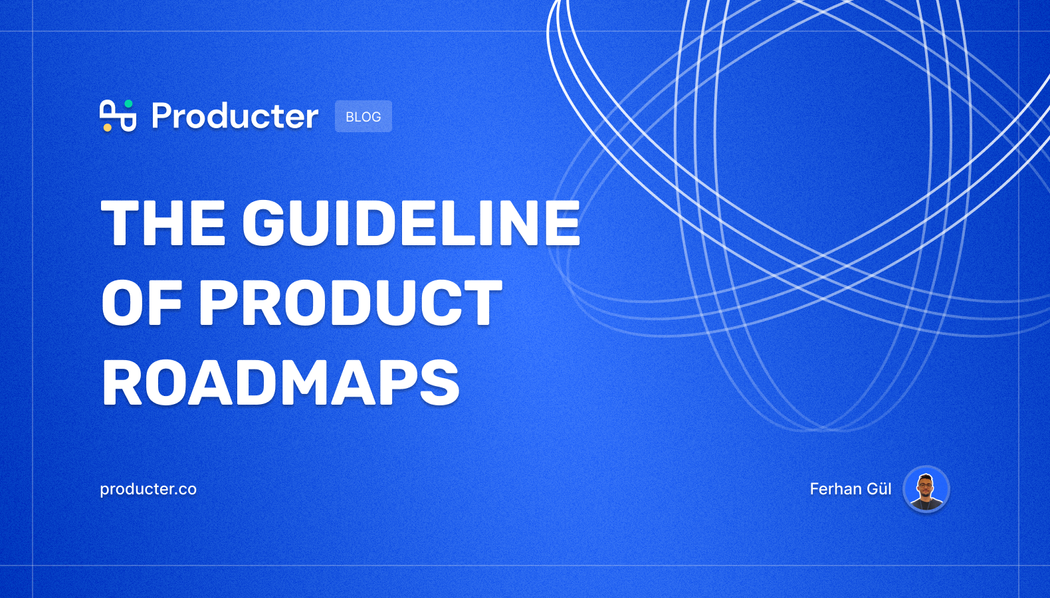Brought to you by Roadmape
A product roadmap is an essential tool for any product team, outlining the strategy, objectives, and key milestones for the development of a product. But creating an effective product roadmap can be a complex and challenging task, requiring careful planning and ongoing management.

From identifying customer needs and setting goals to tracking progress and communicating with stakeholders, we'll cover everything you need to know to create a product roadmap that drives results. Whether you're a product manager, developer, or just starting out in the field, this post will give you the insights and knowledge you need to create an effective product roadmap that sets your product up for success.
In this blog post, we will provide you with a comprehensive guideline for creating and managing a product roadmap, including best practices, tips, and tools that will help ensure success.
What is a Product Roadmaps?
A product roadmap is a high-level visual document that outlines the strategy, objectives, and key milestones for the development of a product. It is a critical tool for product teams, helping them to align on a shared vision and communicate plans to stakeholders.

The product roadmap typically includes a series of initiatives and features that are organized by a timeline, such as a quarter or a year, which outlines the development and delivery plan for the product. It also may include key performance indicators (KPIs) that teams use to measure progress and success.
A good product roadmap should be flexible and adaptable, reflecting the changes in the business environment and the evolving needs of customers. It also needs to be easily understandable and communicable to various stakeholders such as executives, development teams, and customers.
Product roadmaps can take many forms, depending on the specific needs of the team and the product. Some teams may use a simple list of planned features, while others may prefer more detailed roadmaps that include specific timelines and dependencies. Regardless of the format, the main purpose of a product roadmap is to ensure that everyone is working toward the same goals and has a clear understanding of how to achieve them.
It's worth noting that Product roadmaps are not only for software development, but also any field that require planning and development of a product or a service.
Benefits of Product Roadmaps
A product roadmap is a critical tool for product teams because it helps them to:
- Align on a shared vision: A product roadmap clearly communicates the product's vision, objectives, and strategy, which helps everyone to understand the big picture and align on a shared vision for the product.
- Communicate plans to stakeholders: A product roadmap can be used to communicate plans and progress to stakeholders, including executives, development teams, and customers. It helps stakeholders understand what to expect and how the product will evolve over time.
- Prioritize features and initiatives: A product roadmap helps teams prioritize features and initiatives based on strategic goals, customer needs, and available resources. This ensures that teams are working on the most important tasks and that the product is aligned with business objectives.
- Track progress and measure success: A product roadmap can be used to track progress and measure success by setting and tracking key performance indicators (KPIs). This allows teams to understand how the product is performing and make data-driven decisions.
- Adapt to change: A product roadmap is not set in stone and is meant to be flexible and adaptable. It should be regularly reviewed and updated based on the changes in the business environment and the evolving needs of customers.
- Maintaining Focus: A product roadmap helps teams to stay focused on their goals and objectives, by providing a clear view of what the team is currently working on, what is planned for the future, and what has been completed.
Overall, a product roadmap is an essential tool that helps teams to plan, execute and track the development of a product. It helps to ensure that everyone is working towards the same goals and that the product is aligned with business objectives, and bring the product vision to reality.
How to Use Product Roadmaps
A product roadmap is a visual representation of a company's strategy and plans for the development of a product or product line. It typically includes a high-level overview of the product's goals, key features, and milestones, as well as a timeline for their development and release. Product roadmaps can be used by a variety of stakeholders, including product managers, development teams, and senior executives, to align efforts and track progress.

To use a product roadmap, a product manager or other relevant team members will typically begin by defining the overall goals and objectives of the product. This includes identifying the target market, differentiating features, and desired outcomes. Then, they will work with development teams to identify specific features that need to be built, and establish a timeline for their development and release. The resulting product roadmap should be shared with all relevant stakeholders to ensure that everyone is on the same page and working towards the same goals.
It's very important to regularly update and review the roadmap, and make necessary adjustments based on changes in the market, the competition, customer feedback, or company's overall strategy.
It's also important to set priorities based on what's important in the short term, and what has long-term impact, and make sure that the most important features are delivered first
5 headings should be considered when building Product Roadmaps:
Setting goals and objectives: The first step in creating a product roadmap is to define the overall goals and objectives of the product. This includes identifying the target market, differentiating features, and desired outcomes. By clearly defining the goals and objectives, you can ensure that everyone involved in the product development process is working towards the same goal.
Identifying key features: Once the goals and objectives are established, the next step is to work with the development team to identify the specific features that need to be built. This includes researching the competition and customer feedback, as well as identifying the features that will differentiate your product from others in the market. Prioritizing these features based on their importance and impact is also crucial for the success of the product.

Establishing a timeline: After identifying the key features, it's essential to establish a timeline for their development and release. This includes identifying milestones and deadlines, and allocating the necessary resources to meet them. Having a clear timeline helps to keep the product development process on track and ensures that the product will be delivered on schedule.
Keeping the roadmap up to date: A product roadmap is not a one-time document, but an iterative process that should be reviewed and updated regularly. Things like changes in the market, competition, customer feedback, and the company's overall strategy may require adjustments to the roadmap. Therefore, it's essential to have a system in place to ensure that the roadmap stays current and relevant.
Communicating the roadmap: Once the product roadmap is complete, it's essential to share it with all relevant stakeholders, such as product managers, development teams, senior executives, and customers. This will ensure that everyone is on the same page and working towards the same goals. The product roadmap should be a living document, and everyone should have access to it and be able to see the progress being made.
Who uses product roadmaps
A product roadmap is a tool that is used primarily by product managers, development teams, and other stakeholders involved in the planning and development of a product or product line.
The product roadmap is a guide for product teams and companies, ensuring everyone is on the same page
Product managers use product roadmaps to align efforts, track progress, and communicate the product's goals, key features, and milestones to other stakeholders, such as senior executives, sales and marketing teams, and customers. They also use the roadmap to prioritize the development of specific features and to make decisions about when to release new versions of the product.

Development teams also use product roadmaps to understand the overall direction of the product and to plan their work accordingly. They use the roadmap to identify the specific features that need to be built, to estimate the time and resources required to build them, and to track progress on development.
Senior executives and other stakeholders such as Investors or Board members also use product roadmaps to understand the product's direction and progress, and to make decisions about resource allocation, budgeting, and other strategic issues.
In conclusion
A product roadmap is a crucial tool for product managers to have in their toolbox when developing a product. It helps to align efforts, track progress, and communicate the product's direction to all stakeholders. By following the key steps of creating a product roadmap, product managers can ensure that their product is delivered on schedule, meets the needs of their customers, and stands out in the market. Remember to keep your roadmap up-to-date and regularly share it with all relevant stakeholders to make sure everyone is on the same page.
Producter is a product management tool designed to become customer-driven.
It helps you create collect feedback, manage tasks, sharing product updates, creating product docs, and tracking roadmap.


